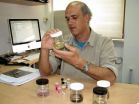According to the National Cancer Institute, more than 232,000 American women developed breast cancer last year and nearly 40,000 women died from the disease. It is the most common cancer among women in the United States. Most breast cancer deaths occur because the cancer has spread, or metastasized, which means that cells in the primary tumor have invaded blood vessels and traveled via the bloodstream to form tumors elsewhere in the body.
In earlier studies involving animal models and human cancer cell lines, researchers found that breast cancer spreads when three specific cells are in direct contact: an endothelial cell (a type of cell that lines the blood vessels), a perivascular macrophage (a type of immune cell found near blood vessels), and a tumor cell that produces high levels of Mena, a protein that enhances a cancer cell's ability to spread. Where these three cells come in contact is where tumor cells can enter blood vessels--a site called a tumor microenvironment of metastasis, or TMEM. Tumors with high numbers of TMEM sites (i.e., they have a high TMEM "score") were more likely to metastasize than were tumors with lower TMEM scores. In addition, the researchers found that cancer tissues high in a form of Mena called MenaINV were especially likely to metastasize. (MenaINV refers to the invasive form of Mena.)
"Those studies revealed new insights into how cancer might spread, but they didn't necessarily show what is happening in patients," said study leader Maja Oktay, M.D., Ph.D., associate professor of pathology http://www.einstein.yu.edu/departments/pathology/) at (Albert Einstein College of Medicine Yeshiva University and attending cytopathologist at Montefiore. Since then, the scientists have extended their research to include patients with breast cancer. In 2011 they published findings on 40 patients showing a correlation between high MenaINV levels and high TMEM scores. The present study combines results from those 40 patients plus an additional 60 patients. All 100 patients had been diagnosed with invasive ductal carcinoma and were being treated at MECCC. Invasive ductal carcinoma is the most common type of invasive breast cancer, accounting for 80 percent of cases. In this disease, the cancer has grown through the duct walls and into the surrounding breast tissue.
For the subset of more recent patients, the researchers assessed tumor cell behavior--in particular, cancer cells' ability to cross the endothelium (inner layer) of blood vessels. They obtained tumor cells using fine needle aspiration and placed them in a novel engineered tissue assay designed to replicate the endothelium of a blood vessel--the barrier that cells must cross so they can spread from a primary tumor to distant sites. Biopsied tumor tissue from all 60 new patients was fixed in formalin and embedded in paraffin so that TMEM sites in the tissue could be counted. Breast cancer cells able to cross the endothelial layer in this assay were found to have higher MenaINV levels compared with the total population of patients' aspirated cells. In addition, finding high levels of MenaINV correlated with finding high numbers of TMEM sites in paraffin biopsy specimens from the same patients. The TMEM "score" for each biopsy specimen was calculated by counting the total number of TMEM sites observed within ten 400x magnification fields. Combining the results from all 100 patients showed that the findings were consistent across the three most common clinical subtypes of invasive ductal carcinoma.
"These results confirm that TMEM sites and MenaINV are essential for the spread of breast cancer in humans," said Dr. Oktay. "They also imply that MenaINV expression and TMEM score measure related aspects of a commonly used mechanism that human breast cancers use to metastasize."
Dr. Oktay noted that "the outcome for patients with metastatic breast cancer hasn't improved in the past 30 years despite the development of targeted therapies. It's critically important to learn more about the metastatic process so we can develop new ways to predict whether cancer will spread and identify new treatments."
The Einstein team is currently working with MetaStat, Inc., a biotechnology company located in Montclair, N.J., to develop a commercial TMEM test for assessing a patient's risk for metastatic breast cancer.
INFORMATION:
The paper is titled "Invasive Breast Carcinoma Cells from Patients Exhibit MenaINV- and Macrophage-Dependent Transendothelial Migration." Other Einstein-Montefiore authors are Jeanine Pignatelli, Ph.D., Sumanta Goswami, Ph.D., Joan G. Jones, M.D., Thomas E. Rohan, M.D., Ph.D., Xiaoming Chen, Esther Adler, M.D., Dianne Cox, Ph.D., Sara Maleki, M.D., Anne Bresnick, Ph.D., and John Condeelis, Ph.D. Other authors were Evan Pieri at Yeshiva University, New York, NY, and Frank B. Gertler, Ph.D., at Massachusetts Institute of Technology, Cambridge, MA.
This work was supported by grants from the National Institutes of Health (CA170507-01 and CA100324), the Breast Cancer Alliance, Department of Defense Breast Cancer Research Program (W81XWH-14-1-0286) and the Einstein Integrated Imaging Program.
Drs. Rohan, Jones, Condeelis, and Gertler are shareholders in MetaStat and receive compensation as consultants to the company. In addition, Dr. Jones was a member of MetaStat's clinical advisory board. The other authors declare no competing interests.
About Albert Einstein College of Medicine of Yeshiva University
Albert Einstein College of Medicine of Yeshiva University is one of the nation's premier centers for research, medical education and clinical investigation. During the 2013-2014 academic year, Einstein is home to 743 M.D. students, 275 Ph.D. students, 103 students in the combined M.D./Ph.D. program, and 313 postdoctoral research fellows. The College of Medicine has more than 2,000 full-time faculty members located on the main campus and at its clinical affiliates. In 2013, Einstein received more than $150 million in awards from the National Institutes of Health (NIH). This includes the funding of major research centers at Einstein in aging, intellectual development disorders, diabetes, cancer, clinical and translational research, liver disease, and AIDS. Other areas where the College of Medicine is concentrating its efforts include developmental brain research, neuroscience, cardiac disease, and initiatives to reduce and eliminate ethnic and racial health disparities. Its partnership with Montefiore Medical Center, the University Hospital and academic medical center for Einstein, advances clinical and translational research to accelerate the pace at which new discoveries become the treatments and therapies that benefit patients. Through its extensive affiliation network involving Montefiore, Jacobi Medical Center - Einstein's founding hospital, and three other hospital systems in the Bronx, Brooklyn and on Long Island, Einstein runs one of the largest residency and fellowship training programs in the medical and dental professions in the United States. For more information, please visit www.einstein.yu.edu, read our blog, follow us on Twitter, like us on Facebook, and view us on YouTube.
About Montefiore Health System
Montefiore Health System is a premier academic health system and the University Hospital for Albert Einstein College of Medicine. Combining nationally-recognized clinical excellence with a population health perspective that focuses on the comprehensive needs of the communities it serves, Montefiore delivers coordinated, compassionate, science-driven care where, when and how patients need it most. Montefiore consists of six hospitals and an extended care facility with a total of 2,080 beds, a School of Nursing, and state-of-the-art primary and specialty care provided through a network of more than 150 locations across the region, including the largest school health program in the nation and a home health program. The Children's Hospital at Montefiore is consistently named in U.S. News' "America's Best Children's Hospitals." Montefiore's partnership with Einstein advances clinical and translational research to accelerate the pace at which new discoveries become the treatments and therapies that benefit patients. The health system derives its inspiration for excellence from its patients and community, and continues to be on the frontlines of developing innovative approaches to care. For more information please visit http://www.montefiorehealthsystem.org and http://www.montekids.org. Follow us on Twitter; like us on Facebook; view us on Youtube.


